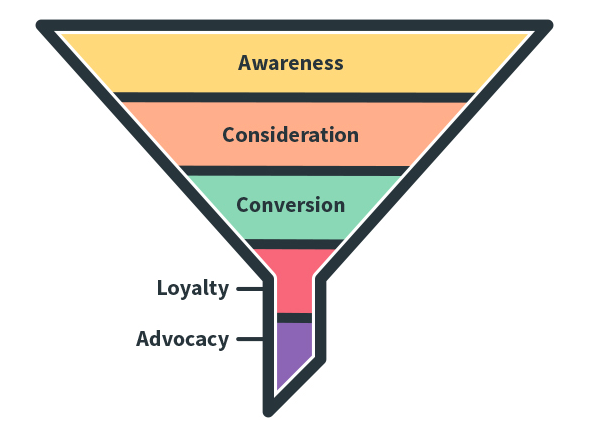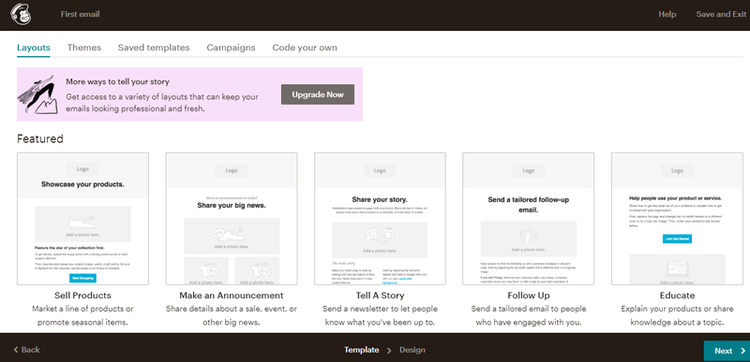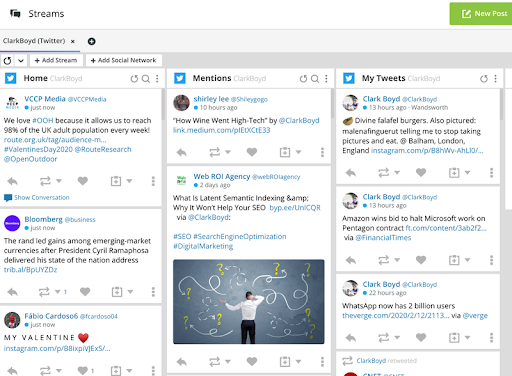A Guide to the Marketing Funnel for Your Small Business
Every business must figure out how to attract customers. But that’s just the start. How do you get them through the buying process? After they make a purchase, what steps do you take to generate repeat business? How can you leverage loyal customers to become advocates for your company?
The marketing funnel answers these questions. It’s a popular business framework designed to help organizations develop a marketing plan. By applying funnel marketing strategies to your business, you improve the success rate of your marketing and sales efforts.
Overview: What is the marketing funnel?
The marketing funnel identifies the key milestones in a consumer’s journey to becoming a loyal client. By breaking down the customer’s buying process into these key stages, a business can tailor marketing and sales strategies to each stage, increasing the ability to drive customers from one stage to the next.
The concept is referred to as a funnel because the idea is that you cast a wide marketing net at the top of the funnel to reach as many people as possible. As your marketing efforts zero in on the consumers most likely to buy, this pool of people grows smaller.
The image of a funnel captures this idea with a broad audience at the top, narrowing down to a smaller group at the bottom, who will become your customers.
Traditional marketing and sales funnels conclude at the conversion point, where a purchase is made. That’s why marketing funnels are sometimes referred to as purchase funnels.
Modern marketing funnels are more comprehensive. They go further and encompass retention factors related to customer loyalty and advocacy. With these levels added beyond the purchase stage, your funnel can more accurately reflect the customer life cycle, and strengthen your sales growth.

This illustration shows the various stages of the marketing funnel. Image source: Author
You can measure the effectiveness of the tactics used in each marketing funnel stage by tracking various metrics. These metrics will differ based on the funnel stage and tactics used. Performance tracking allows you to try different marketing strategies and assess which are most effective.
Manually collecting and analyzing marketing data is time-consuming, so use software designed to handle this. It can be a tool such as CRM software, marketing automation software, or a website analytics platform such as Google Analytics.
A breakdown of the marketing funnel stages
Since consumers at each stage of the marketing funnel are at different points along the path to purchase, they must be targeted with different marketing strategies. Let’s look at what’s involved at each stage.
1. Awareness
At this stage, you’re marketing to a wide universe of potential customers to raise their awareness of your business and its products or services.
Before you execute any marketing tactics, identify your target audience. What criteria should consumers meet to be a fit for your offerings? Is it a certain income level, or an interest in particular hobbies?
If you sell running shoes, you target people interested in related activities so your efforts are more likely to capture their attention.
Once you know your target audience, you can take two general marketing approaches to reach this audience: inbound marketing and outbound marketing.
Inbound marketing pulls customers to you. Outbound marketing pushes your message out to consumers, generally through advertising. You can mix the two, or focus on one that makes the most sense for your business and budget.
Content is easy to find on the internet today, so inbound marketing is considered more effective, and generally less expensive, than outbound. A few of the digital marketing tactics involved in inbound include:
- SEO: Search engine optimization (SEO) is a technique to create and optimize content to rank higher in search engines such as Google, when readers search for keywords that describe your content.
- Blog posts: This tactic employs the principles of content marketing by offering educational articles of interest to your target audience. They’re designed to give advice or helpful insights on topics related to your business or industry, and consequently, draw consumers to your site who are interested in this information. These educational, informative posts also showcase your company’s knowledge and expertise, building your brand with the target audience.
- Infographics: Infographics are visual diagrams that present interesting statistics in a succinct, eye-catching way. It’s a form of marketing collateral that attracts consumers to your website through both the visuals of the infographic and the information it presents.
With outbound marketing, you’re primarily using ads, like a billboard or digital platforms such as Google’s advertising network. Other outbound approaches include distributing flyers in your neighborhood or attending trade shows.
Inbound and outbound marketing share the same goal: get as many of your target audience to your website or place of business as possible. The objective then is to convert visitors into leads to drive them towards the next phase of the funnel.
Awareness metrics: Success at the awareness stage is measured by the number of people exposed to your business, such as a count of the people who saw your ad or visited your website.
2. Consideration
At the consideration stage, consumers interested in your business and its offerings are considering whether or not to buy. They may express interest by signing up for your email list or requesting a white paper. These consumers are classified as leads.
If you use sales staff, the leads pass to them at this point, so the sales rep can follow up and close the sale. If you don’t have sales reps, the marketing team would begin outreach activities to drive leads further down the marketing funnel.
Strategies in this phase focus on educating consumers on why your offerings best meet their needs. Tactics to achieve this goal include:
- Email marketing: Email marketing is an effective way for businesses to connect with consumers. When you use email marketing software to execute an email marketing campaign you streamline tasks and access reports to analyze the performance of your emails.
- Case studies: A case study validates the effectiveness of your product by detailing a real example of how other customers benefited from your solution. Studies show potential clients how your offerings deliver tangible benefits, creating trust in your offerings.
- Retargeting: Retargeting is a form of online advertising designed to show ads only to people who previously visited your website. You’ll target consumers from the awareness stage. It’s an efficient, effective way to follow up with potential customers and remind them about your offerings.
Consideration metrics: Metrics to track here might measure how many email sign ups you achieved, how much time consumers spent on your site, and how many people clicked on your retargeting campaign ads.
3. Conversion
This is where people buy. Your goal is to get as many people as possible from the first two stages of your marketing funnel to this purchase point.
Tipping consumers towards conversion can be challenging. Here are some tactics to help:
- Eliminate friction: Remove any obstacles to purchase. For example, if you’re an e-commerce company and visitors to your website are abandoning products in the shopping cart, what’s causing them to stop short? Perhaps shipping costs are too high or you have too many steps. Reduce these obstacles and see if your conversion rate goes up.
- Incentives: Offer an incentive. A small incentive can create enough encouragement for consumers to buy. This can include free shipping on any products above a specific amount or a free trial period for a service offering.
Conversion metrics: Conversion rate is an important metric to track at this stage because it measures how many consumers ultimately end up buying. You can track conversion rate back to specific marketing tactics and double down on those.
4. Loyalty
Marketing to existing customers is key to keeping them engaged in your business. That’s why a robust marketing funnel includes the loyalty stage, which is all about customer retention.
We extend the marketing funnel beyond the purchase phase because it’s far cheaper to retain existing customers than hunt for new ones. Plus, existing customers are more likely to make purchases since they previously experienced your product or service, and know what to expect. You bypass the whole consideration/conversion dynamic.
Apple is a company with strong loyalty. Customers line up at Apple stores to buy the latest iPhone. Boost your customer loyalty with marketing tactics such as:
- Loyalty programs: By rewarding customers for repeat purchases, you encourage them to keep shopping with you instead of competitors. Starbucks is a perfect example. Their reward program gives customers free food and drinks based on points accumulated through purchases.
- Email marketing: Use email to remind existing customers of your business. Keep them engaged by periodically reaching out to them with special discounts or other offers, and update them with relevant news about your business, such as new products.
- Newsletters: Another effective engagement tactic is a regular newsletter. It’s typically delivered via email and focuses on delivering helpful information with a mix of incentives to encourage additional purchases. The newsletter conveys less of a salesy feel than email marketing content, so it can be a more inviting way to stay connected to your customers. Email marketing software, such as Mailchimp, can be used to execute both email marketing and newsletters.

Mailchimp supports both email marketing and newsletters through customizable templates. Image source: Author
5. Advocacy
Once you have a solid customer retention program in place, take it to the next level. The advocacy phase at the bottom of the funnel is about encouraging your customers to recommend your business to others, thereby generating new customers.
Let’s say you’re marketing a dental practice. Rather than increasing your marketing spend on the awareness phase of the funnel to generate new clients, it’s more effective if your existing customers recommend your practice to others.
Recommendations increase the likelihood of consumers trying your products or services, and they tend to lead to faster conversions.
Tactics used to drive advocacy include:
- Surveys: Use surveys to collect input on your products and services. Showing that you care what your customers think and incorporating their feedback into improvements demonstrates that your customers matter.
- Business improvements: If your survey uncovers areas that create friction for customers, like a cumbersome return policy, address those, enhancing the customer experience. Taking action to improve your business will delight your clients, raising the likelihood that they’ll advocate on your behalf.
- Referral program: Create a referral program that incents customers who bring new clients to your business, such as offering a discount to your customer’s friends and family. Tesla’s referral program offered customers $1,000 for every referral who bought one of its cars.
Advocacy metrics: Track your advocacy efforts by measuring the percentage of customers who come through your referral program. Also gauge sentiment by what customers are saying on social media. Small businesses that don’t have the time or resources to devote to social media can use software tools, such as Hootsuite, to streamline the monitoring and management of various social media outlets.

Hootsuite’s dashboard aggregates the social media outlets you’re monitoring. Image source: Author
Benefits of using a marketing funnel for your small business
A marketing funnel gives you more than the framework for building your marketing strategy, it assists the success of your business in other ways.
1. Increases sales
A structured marketing plan coupled with metrics analysis aligned to the various stages of the funnel allows you to fine tune your marketing strategy and grow sales.
Let’s say not many customers go beyond awareness to the consideration stage. You can dig into the website pages where visitors are spending time before leaving, called exit pages. Perhaps these pages are light on content that explains the benefits of your products or services.
Or maybe it’s difficult to find where to sign up for your email list. Make changes, then monitor again to verify you’re seeing improvement.
This iterative approach refines each stage of your marketing funnel to maximize results.
2. Improve customer understanding
Analyzing customer behavior as they move through the marketing funnel delivers client insights. You acquire a deeper understanding of your customers and what draws them to your business, the factors that improve conversions, and what can strengthen customer retention.
For example, if you include case studies on your website but conversions only improve after posting educational videos, you can conclude clients prefer watching videos to learn about your business. So create more of them and back off on case studies.
3. Focus on the right leads
In the first stage of the marketing funnel, you’re casting a broad net. As you see which consumers choose to make a purchase, you’re able to refine your picture of the ideal target audience. You then zero in on the kinds of consumers with the highest likelihood to convert.
Can the marketing funnel change?
The marketing funnel is not always a linear process. Some consumers, discovering your business, go straight to the purchase phase, and some spend extended time in the consideration stage.
To reflect this, various marketing funnel concepts add layers between the awareness and conversion stages, and others aren’t diagrammed as a funnel at all.
The traditional AIDA marketing funnel provides a view of the customer journey that ends at the conversion stage. AIDA stands for awareness, interest, desire, and action.
These align to the marketing funnel stages discussed previously except that AIDA includes a desire phase to represent the process of building up consumer excitement for your offerings.
AIDA excludes the important post-purchase phases of a business, which is why most modern businesses add loyalty and advocacy to their funnels. I worked at a company that executed AIDA well, but still struggled to grow revenue because the business could not retain customers.
Other marketing funnels employ a circular diagram, like a flywheel, to better represent that customer acquisition and retention are both equally critical to business success.
This model incorporates the loyalty and advocacy stages mentioned above. In this way, the buying funnel becomes more of a customer funnel, where customer needs are at the center.
B2B vs. B2C: How does the marketing funnel differ?
Whether you’re a business-to-business (B2B) or business-to-consumer (B2C) company will make a difference in how you apply the marketing funnel.
With B2B companies, the marketing and sales teams focus on different parts of the marketing sales funnel, working together to deliver a cohesive strategy.
The marketing team tackles the awareness stage, generating leads which the sales team then works to convert into purchases. Once the sales team gets customers past the conversion phase, both sales and marketing work together on the loyalty and advocacy stages to retain customers.
Another key difference is that B2B offerings are usually more complex or expensive, leading customers to evaluate a product or service over several weeks or months before making a purchase.
Once a decision to buy is reached, the purchase process usually requires the involvement of a salesperson or other company representative to execute the buy.
In a B2C environment, a sales team often doesn’t exist, so marketing drives the entire funnel process. Consumers typically complete purchases without the need to interact with a company representative, and those purchase decisions tend to occur in a shorter timeframe than in a B2B setting.
Final advice on the marketing funnel
Note that the marketing funnel is different from the customer journey. They are two sides of the same coin, but the former is about your company’s efforts to drive customers to conversion, and ultimately, advocacy.
The latter documents the customer’s steps and struggles to engage with your business from their perspective.
Before creating a marketing funnel strategy, obtain insights into the customer journey by creating a customer journey mapping.
This allows you to better understand how to strengthen and streamline the purchase process for your clients, eliminating friction and increasing the effectiveness of your marketing activities.
Use the marketing funnel to tailor your actions to appropriately address customer needs at each stage. You will serve the needs of your customers better, and that grows your business.
Alert: our top-rated cash back card now has 0% intro APR until 2025
This credit card is not just good – it’s so exceptional that our experts use it personally. It features a lengthy 0% intro APR period, a cash back rate of up to 5%, and all somehow for no annual fee! Click here to read our full review for free and apply in just 2 minutes.
Our Research Expert
We're firm believers in the Golden Rule, which is why editorial opinions are ours alone and have not been previously reviewed, approved, or endorsed by included advertisers. The Ascent does not cover all offers on the market. Editorial content from The Ascent is separate from The Motley Fool editorial content and is created by a different analyst team.
Related Articles
View All Articles